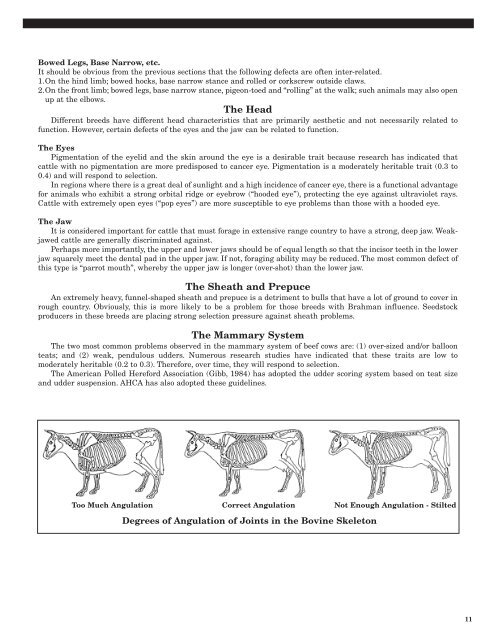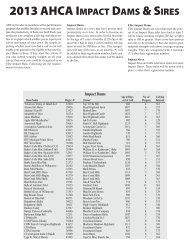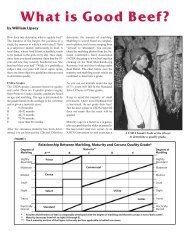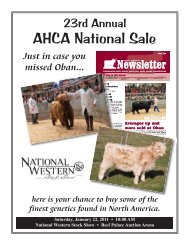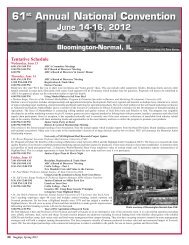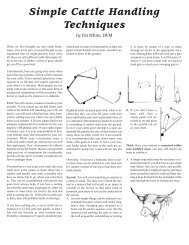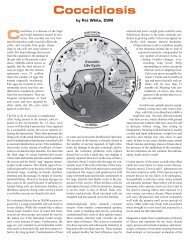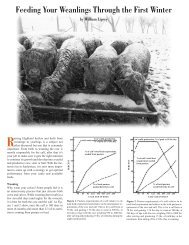The Bagpipe - American Highland Cattle Association
The Bagpipe - American Highland Cattle Association
The Bagpipe - American Highland Cattle Association
Create successful ePaper yourself
Turn your PDF publications into a flip-book with our unique Google optimized e-Paper software.
Bowed Legs, Base Narrow, etc.<br />
It should be obvious from the previous sections that the following defects are often inter-related.<br />
1.On the hind limb; bowed hocks, base narrow stance and rolled or corkscrew outside claws.<br />
2.On the front limb; bowed legs, base narrow stance, pigeon-toed and “rolling” at the walk; such animals may also open<br />
up at the elbows.<br />
<strong>The</strong> Head<br />
Different breeds have different head characteristics that are primarily aesthetic and not necessarily related to<br />
function. However, certain defects of the eyes and the jaw can be related to function.<br />
<strong>The</strong> Eyes<br />
Pigmentation of the eyelid and the skin around the eye is a desirable trait because research has indicated that<br />
cattle with no pigmentation are more predisposed to cancer eye. Pigmentation is a moderately heritable trait (0.3 to<br />
0.4) and will respond to selection.<br />
In regions where there is a great deal of sunlight and a high incidence of cancer eye, there is a functional advantage<br />
for animals who exhibit a strong orbital ridge or eyebrow (“hooded eye”), protecting the eye against ultraviolet rays.<br />
<strong>Cattle</strong> with extremely open eyes (“pop eyes”) are more susceptible to eye problems than those with a hooded eye.<br />
<strong>The</strong> Jaw<br />
It is considered important for cattle that must forage in extensive range country to have a strong, deep jaw. Weakjawed<br />
cattle are generally discriminated against.<br />
Perhaps more importantly, the upper and lower jaws should be of equal length so that the incisor teeth in the lower<br />
jaw squarely meet the dental pad in the upper jaw. If not, foraging ability may be reduced. <strong>The</strong> most common defect of<br />
this type is “parrot mouth”, whereby the upper jaw is longer (over-shot) than the lower jaw.<br />
<strong>The</strong> Sheath and Prepuce<br />
An extremely heavy, funnel-shaped sheath and prepuce is a detriment to bulls that have a lot of ground to cover in<br />
rough country. Obviously, this is more likely to be a problem for those breeds with Brahman influence. Seedstock<br />
producers in these breeds are placing strong selection pressure against sheath problems.<br />
<strong>The</strong> Mammary System<br />
<strong>The</strong> two most common problems observed in the mammary system of beef cows are: (1) over-sized and/or balloon<br />
teats; and (2) weak, pendulous udders. Numerous research studies have indicated that these traits are low to<br />
moderately heritable (0.2 to 0.3). <strong>The</strong>refore, over time, they will respond to selection.<br />
<strong>The</strong> <strong>American</strong> Polled Hereford <strong>Association</strong> (Gibb, 1984) has adopted the udder scoring system based on teat size<br />
and udder suspension. AHCA has also adopted these guidelines.<br />
Too Much Angulation Correct Angulation Not Enough Angulation - Stilted<br />
Degrees of Angulation of Joints in the Bovine Skeleton<br />
11


